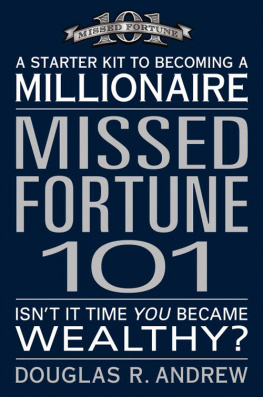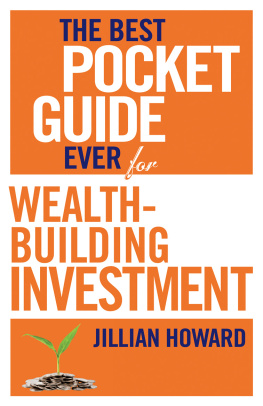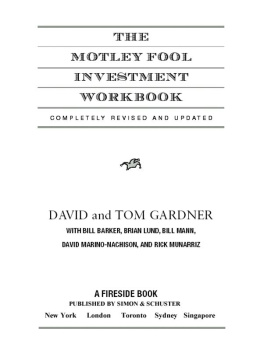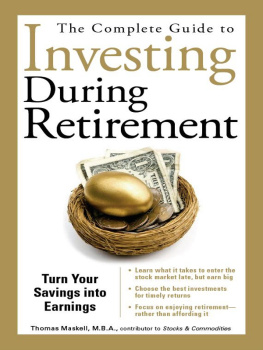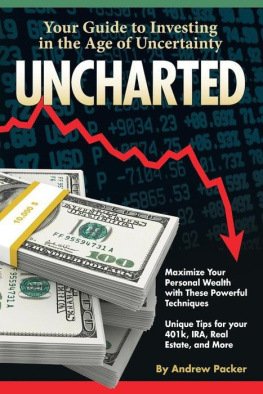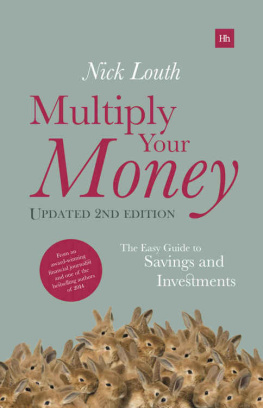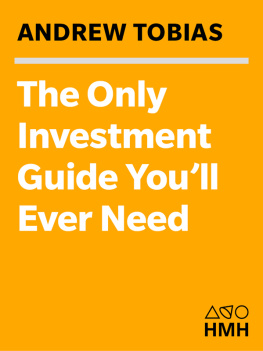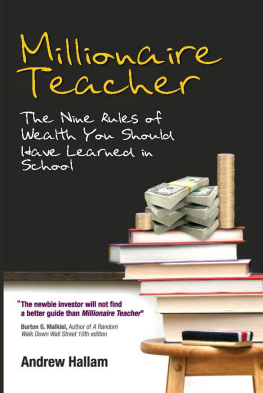Copyright 2016, 2010, 2005, 2002, 1998, 1996, 1989, 1987, 1983, 1978 by Andrew Tobias
Second Mariner Books edition 2016
All rights reserved
For information about permission to reproduce selections from this book, write to or to Permissions, Houghton Mifflin Harcourt Publishing Company, 3 Park Avenue, 19th Floor, New York, New York 10016.
www.hmhco.com
Library of Congress Cataloging-in-Publication Data is available.
ISBN 978-0-544-78193-1
The prices and rates stated in this book are subject to change.
Quotation by John Templeton on reprinted courtesy of Mutual Funds magazine.
Graph on : Courtesy of the author.
Graph on .
Cover design by Faceout Studio, Emily Weigel
e ISBN 978-0-544-77141-3
v1.0416
To my brokereven if he has,
from time to time, made me just that.
A CKNOWLEDGMENTS
I would like to thank Sheldon Zalaznick and Clay Felker, the wonderful editors, much missed, with whom I worked most closely at New York magazine when this book was first written... the estimable Less Antman, for persuading me to revise itand for providing, over the years, a tremendous amount of invaluable help, insight, and good humor in the bargain... Carol Hill, my editor on the original edition, and Ken Carpenter, my editor on this one... Sheldon Richman, Barbara Wood, and Rachael DeShano, for their close readings... Ibbotson Associates for their market statistics... Jerry Rubin and Bart Barker, among many others from the computer software world... John Kraus, Laura Sloate, Martin Zweig, Burton Malkiel, Alan Abelson, Ken Smilen, Yale Hirsch, Charles Biderman, Paul Marshall, Robert Glauber, Murph and Nancy Levin, Jesse Kornbluth, Jack Egan, Marie Brenner, Peter Vanderwicken, Eugene Shirley, Walter Anderson, David Courier, John Koten, Joel Greenblatt, Jane Berentson, Bryan Norcross, Brandon Fradd, Steve Sapka, Chris Brown, Zac Bissonnette, Bob Tortora, Brian Gatens, Victor Jeffreys II, and Charles Nolan (who, though departed, remains in charge)... Forbes, Google, the Wall Street Journal, and the New York Times. Although much of what I know I have learned from these people and institutions, whatever egregious faults youor theymay find with this book are strictly my own.
P REFACE
I F IT IS brassy to title a book The Only Investment Guide Youll Ever Need, its downright brazen to revise it. Yet not to do so every few years would be worse, partly because so many of the particulars change, and partly because so many people, against all reason, continue to buy it.
In the 38 years since this book first appeared, the world has spun into high gear. Back then, there were no home-equity loans, no 401(k) retirement plans or Roth IRAs... no variable annuities to avoid or index funds to applaud or adjustable rate mortgages to consider... no ETFs, no 529 education funds, no frequent-flier miles (oh, no!), no Internet (can you imagine? no Internet!)not even an eBay, Craigslist, or Amazon. (How did anyone ever buy anything?)
The largest mutual fund family offered a choice of 15 different funds. Today: hundreds. Stock prices were quoted in fractions and New York Stock Exchange volume averaged 25 million shares a day. Today: 3 billion shares would be a slow day.
The top federal income tax bracket was 70%.
The basics of personal finance havent changedthey never do. There are still just a relatively few commonsense things you need to know about your money. But the welter of investment choices and the thicket of jargon and pitches have grown a great deal more dense. Perhaps this book can be your machete.
T HE B IG P ICTURE
N OT LONG AFTER this book first appeared in 1978, the U.S. financial tide ebbed: stock and bond prices hit rock bottom (the result of sky-high inflation and interest rates) and so did our National Debt (relative to the size of the economy as a whole). Investing over the next three decadesas difficult as it surely seemed at timeswas actually deceptively easy, as the tide just kept coming in.
Now were in (roughly, vaguely) the opposite situationvery low inflation, very low interest rates, and an uncomfortably high National Debtmaking the years ahead a particular challenge.
Understanding that challengeseeing the big picturewill help you put events and decisions in context.
Take a minute to consider the National Debt and interest rates; then another minute to consider the good stuff.
National Debt
In 1980, the National Debtwhich had peaked at 121% of Gross Domestic Product in 1946 as a consequence of the need to borrow whatever it took to win World War IIhad been worked back down to 30%.
Its not that we repaid any of it, just that the economy gradually grew to dwarf it.
Whether for a family or a business orin this casea nation, having a low debt ratio is healthy. It gives you wiggle room if you ever run into trouble, like a recession, and need to borrow.
Indeed, that had long been the big idea: that in bad times governments should lean into the wind and run deficits... borrowing to boost demand and ease the pain while excess business inventories were gradually worked down... and then, in good times, not borrow much, or even run a surplus, to build borrowing capacity back up.
Yet in the mostly good years since 1980, our National Debt has ballooned. From 30%, when the Reagan-Bush team took over, it topped 100% in the fiscal year George W. Bush passed it on to his successor. (Only between Bush Senior and Junior was the annual deficit tamed, as Clinton handed off what Fortune called surpluses as far as the eye could see.)
Although the deficit has once again been tamed as of this writingmeaning that the National Debt is once again growing more slowly than the economy as a wholethe wiggle room is largely gone.
I wrote in this space five years ago, with the unemployment rate hovering just under 10% and home foreclosure rates peaking, We will get through this and emerge more prosperous than ever. But the decade ahead will be more about hunkering down and retooling than about jet skis and champagne. And, indeed, the unemployment rate has fallen to 5.0%, as I write this in early 2016; foreclosures are running at their lowest rate since 2007; and the stock market is more than double its March 2009 low. So we did get through it.
Even so, the nations infrastructure has been allowed to decay badly; the National Debt may require 35 years to shrink back to 30% of GDP, as it gradually did in the 35 years following World War II; and many of the new jobs dont pay nearly as well as the ones theyve replaced. So its still too soon for the champagne.
Interest Rates
In 1981, Uncle Sam said: Lend me $1,000 for two years and Ill pay you $336 in interest. In early 2016, Uncle Sam was saying, Lend me that same $1,000 and Ill pay you $20. And people were rushing to take it.
So it is a very different world.
In 1981, investors willing to take a risk on stocks or long-term bonds knew thatif inflation didnt spin entirely out of controlinterest rates would eventually fall, making the prices of both stocks and bonds rise.
In 2016, investors have to understand thatwhatever may come firstinterest rates eventually will rise, making bond prices fall (see ) and stocks relatively less attractive as well. (The more interest you can get from safe bonds, the less reason to take a risk with stocks.)
None of this is to say stocks cant go up if interest rates do. They absolutely can if rates dont go too high and sit atop healthy economic growth. But as a general rule, falling rates boost profits and stock prices. And for nearly 35 years, long-term interest rates generally


